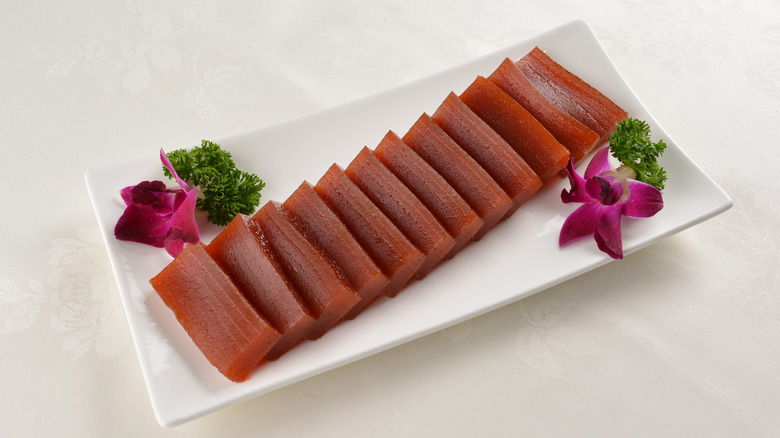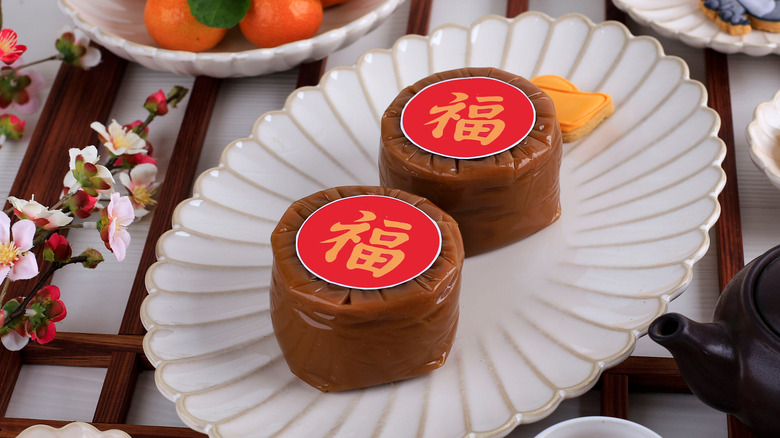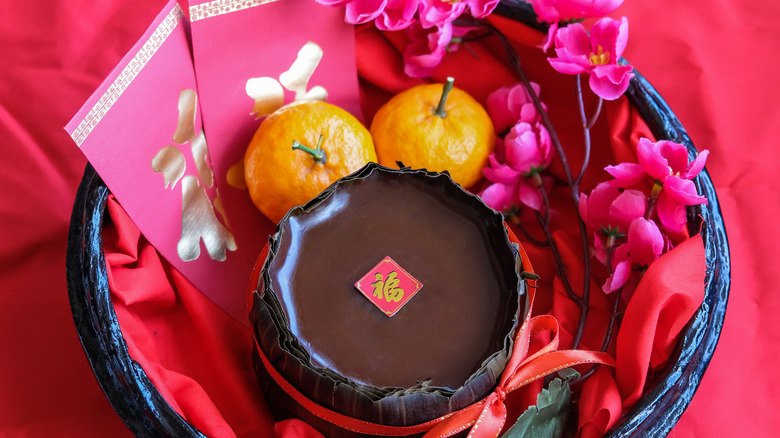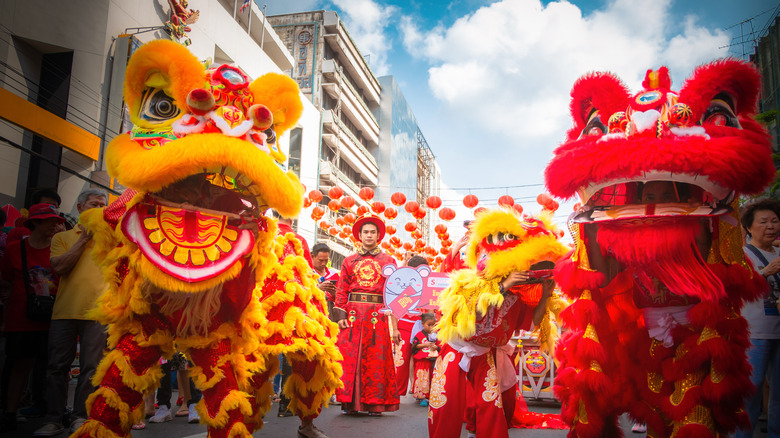The Folklore Behind China's Sticky Cake, Nian Gao
It's a Lunar New Year treat that goes by different names, depending on the Chinese dialect that's used to refer to it. If one is Southern Chinese Hokkien or Peranakan the treat is known as ti kuih, and if one is Malaysian, it is called kuih bakul, per Messy Witchen. Filipinos and Filipino Chinese refer to the treat as tikoy, says Panlasang Pinoy. The Cantonese call the cake nin go, and it's called tian ba or ba kuang by the Hainanese, per CNY Cookies. But to others, the seasonal treat consumed during the holiday is known as nian gao or sticky rice cake, (via Red House Spice).
Nian gao can take on different forms and flavors, depending on where the family feasting on this sticky seasonal treat might be. CNY Cookies says rice cakes made in Northern Chinese provinces like Shanxi and in Mongolia are usually white and yellow in color. They may come with red bean paste or mashed jujube filling. In Beijing, rice cakes might also be made with yellow rice or noodles and stuffed with a jujube and red bean mix. The version of nian gao that dominates across many regions in China from its southern provinces to the port city of Shanghai and the offshore island of Hainan is one made with glutinous rice.
Nian gao can represent higher aspirations
At its most basic, a nian gao will be made with water, ginger, a mix of spices, dates, and orange zest, writes The Woks of Life. In Hong Kong, the treat is decidedly more sophisticated, and made with rice flour, glutinous rice flour, coconut juice, and coconut sugar, per SCMP. The sticky rice cake is sliced thinly and pan-fried either on its own or with a beaten egg, adds Huang Kitchen.
And while it has many names, it is nian gao's Mandarin monicker that merits the most discussion. Like most treats and traditions associated with the Lunar New Year, the name of this cake is a homograph; it is also a way of saying "year high." China Highlights says this reflects a general wish for a better year ahead for those consuming it. That could mean wishes for better pay and a better or higher position; it can even represent a family's wishes for children to grow taller, per SCMP. The sticky rice cake is normally consumed on the first day of the Lunar New Year.
But these wishes for success don't cover the beliefs and stories surrounding this auspicious treat, all of which involve mythical gods, monsters, and enterprising military commanders.
Nian gao has different folk origin stories
Nian gao has different origins. To some, it is an offering to the Kitchen God, who has a spot in every house. Come Lunar New Year, the only way to keep the god from spilling the beans on a family's behavior throughout the year is to give him nian gao, which can have the effect of gluing his mouth shut, explains China Highlights. It's like trying to bribe your Elf on a Shelf with a particularly sticky peanut butter sandwich before he reports back to Santa. Atlas Obscura says in some cases, families even rub the sweet and sticky nian gao on the lips of a poster of the Kitchen God to keep him from ratting on them. But another, less naughty twist sees families offering the Kitchen God some nian gao as a way of asking for good wishes for the year ahead, per SCMP.
There is also a legend surrounding the origin and popularity of nian gao that involves a Chinese general named Wu Zixu. The general's people were trapped inside a walled city with no food in sight. Many had starved to death before survivors remembered the general's words – to dig beneath the city's walls to get food, and when they did, soldiers subsequently found the wall's foundations to be made with glutinous rice flour which saved lives. In honor of that general, nian gao, or sticky rice cake, would be made every year (via China Highlights).
Nian gao could be named after a flesh eating monster
Hong Kong chef Lau Chi-man, who prepares dimsum for the Michelin-starred Duddell's, told SCMP that there is a third folk-based origin story for nian gao. This one features a monster named Nian who normally lived on animal flesh but used the winter to indulge his appetite for humans. The story is said to have many variations, but all end the same way – plenty of rice cakes are made to distract the monster, which in turn saves the lives of beleaguered humans. And to honor that effort, the sticky cakes are made to this day.
Atlas Obscura says the legend surrounding Nian doesn't just involve food – it involves a bit of drama, too, because the lion and dragon dances seen in different Chinatowns across the country are actually a re-enactment of Nian's reign of terror before he is chased away by a combination of sticky rice cake and fireworks.



